Brewing Jasmine
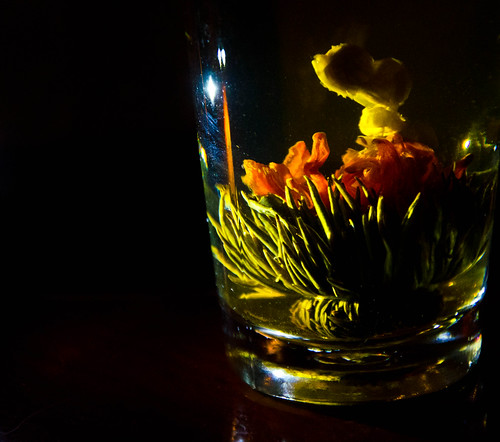
We had jasmine bushes growing in abundance in my village - almost in every household's garden. Even my frugal family - which had a strict policy about growing only useful things such as vegetables, medicinal herbs and and fruit trees - had one growing at our courtyard in front of the house. The poor little bush would release its intoxicating aroma even when it looked rather miserable. It never seems to give up on flowering, at any given season, And at one point I was tempted to make a cup of homemade jasmine tea, simply by letting a single flower float on top of my cup of boiled water. It smelled like heaven, tasted as bitter as death, and left my tongue numb!
The technique of perfuming tea with flowers is an ancient art that was invented in China. During the Han Dynasty (206 BC - 220 AD), J. sambac from Persia arrived in China. By the 5th Centruy, teas were already perfumed with jasmine flowers. But it wasn't until the Qing Dynasty (1644-1912) that jasmine tea because popular the world over due to its introduction to the West.
By nature's own divine wisdom, tea gardens fortunately grow in close proximity to where some fragrant flowers can also thrive. All shades of tea can be perfumed with jasmine, including silver needle, red tea and oolong - but the most popular of them is jasmine green tea.
The technique of perfuming tea was originally developed to enhance the aroma of lower quality leaf, but because of demand and growing appreciation for this particular flavour, there are now many different grades, forms and qualities available, especially for jasmine tea.
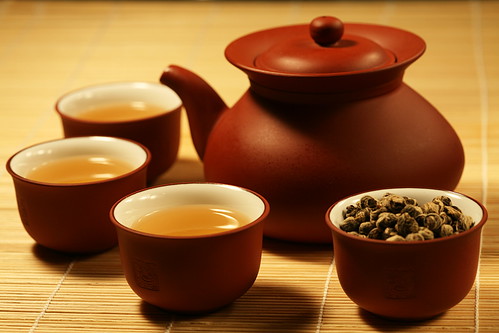
Green jasmine tea is mostly produced in Fujian province in China, and is harvested in September - the prime time for jasmine sambac flowers in the region. The tea leaves and flowers are harvested at dawn. The tea goes a partial process, up to the stage of "fixing" by heat. While the tea leaves are still humid they are layered alternately to form an inch-thick carpet with fresh jasmine flowers. These flowers are left there for about 24 hours so that the tea leaves can absorb their perfume. The tea leaves are then heated for an hour to set the fragrance in, and the flowers are then removed before they begin to decompose so that the scent does not deteriorate. This same process will be repeated with a new batch of flowers, between 2-6 times. Between 30-50 kg of flowers are required to perfume 100 kg of undried tea leaves.

Jasmine tea is recommended for pairing with coconut desserts, and in general all mildly sweetened Asian desserts go fantastically well with it, which is possibly why you'll be served a pot of jasmine tea as soon as you sit down for dim-sum. It is also served to accompany the pho - the deliciously light Vietnamese noodle soups, where the jasmine's aroma beautifully complements the fresh cilantro and basil leaves. Jasmine Tea Mooncakes (pictured above) are a traditional food of the Mid-Autumn Festival celebrated in mainland China, Taiwan, Vietnam and among Chinese communities the world over. It's a pastry that is filled a paste or a cream made of taro root or lotus-seed or a variety of other modern interpretations, to which other flavours (such as tea, fruits, nuts, and more recently also coffee and chocolate) can be added.
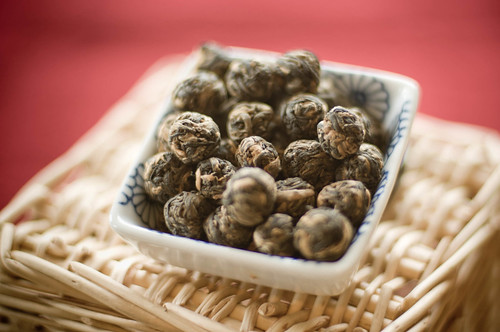
For Jade Jasmine Pearls, the choicest tea leaf is selected: a tiny twig with the entire bud and two leaves (similar to Bai Mu Dan, AKA White Peony), which are impregnated with jasmine's perfume and rolled into a pearl-sized ball.
Jasmine Silver Needle is a fine white tea in which the tender leaves are picked when they are still closed. They look like a needle, and their silvery fuzz in clear sight, which explains their name. In the brewing process, these tiny silver hairs separate form the leaves and float to the top of the cup, creating a beautiful light-reflecting shimmer that adds to the visual enjoyment of the tea. Some flowers may be found in these teas, but this is from a different variety that is not as bitter.
Jasmine Green Tea is the most popular, and the one that you will most likely find in an adulterated form. Watch out for tea blends that have many blossoms in them - these usually serve only a decorative purpose (most jasmine flowers do not retain their aroma after drying), and are a visual clue that the tea is, in fact, aromatized.
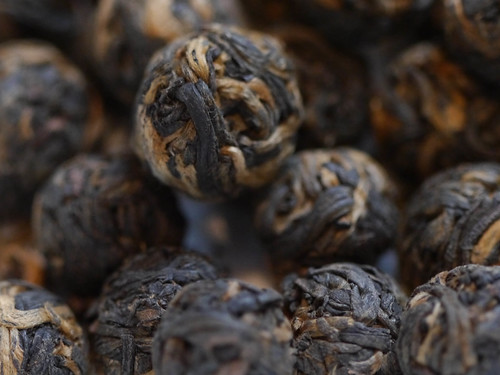
Jasmine Black Tea is rare, and usually scented with a unique, fragrant variety of yellow jasmine, Jasminum odoratissimum is a Madeira (Portugal) variety but due to its quality of retaining its fragrance after drying, it is also grown in Formosa (Taiwan) where it is used to perfume tea. I've only encountered black jasmine tea in the form of hand-tied teas.
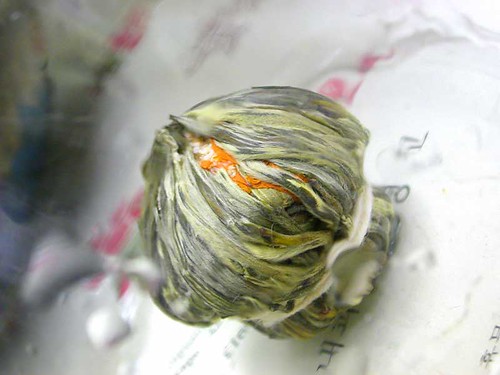
Hand-Tied Teas come in a variety of flavours, colours and designs that open up only after the "tea bud" is steeped in water for a while. The flower unfolds like a slow-motion time-lapse of a blooming bud. For best visual effect, use a clear glass teapot to brew this tea. They can be re-steeped many times, provided they are fresh.
Jasmine Beer: I've had the pleasure to experience a Jasmine IPA (Indian Pale Ale) from Steamworks, a local craft brewery located near the Waterfront Station in Gastown. It is hoppy in the most refreshing, fruity-bitter manner, which only accentuates the subtle jasmine tea notes that are hidden within. I see that there are many other jasmine IPAs produced by craft breweries. But if you can't get your paws on one, you can brew your own Jasmine Kombucha (see recipe below).
Jasmine Kombucha: When I learned that you could, in fact, used flavoured teas for kombucha brewing, I thought that my mind was going to explode from happiness (and ideas). Sometimes the best things are the simplest ones. Taking a fine ingredient, and making it even finer by a traditional, tried-and-true process. The key here is to have a good, healthy kombucha, and use the finest jasmine tea you can get. Another important component of a successful flavoured kombucha-making is that if you are using flavours, only to make them occasionally. The oils in flavoured teas do not add to the health of the culture. So you must alternate between making flavoured ones to plain ones. Follow the recipe for kombucha provided on this blog, using high quality jasmine-scented tea. You may also use flowering (hand-tied) teas, though this may be a bit of a waste of a beautiful thing (visually speaking).

